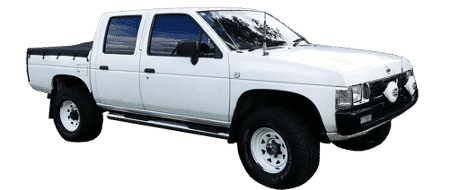D21 Series (1986 – 1997)
Owners Manual
- Navara D21 Series Owners Manual
- Navara D21 Series Specifications
Workshop Manual
- Navara D21 Series Service Manual

The D21 generation was the successor to the Datsun 720, sold as the Nissan Datsun Truck in Japan. The name Navara was used in some markets such as Australia.
In North America, the company used the name “Datsun” from model years 1980 to 1983 then renamed itself “Nissan Datsun” in 1984 and then “Nissan” beginning with the 1985 model year line of trucks and cars alike. Nonetheless, the Nissan pickups continued to be marketed in the Japanese home market as the “Nissan Datsun”. The D21 series were unofficially called Nissan Hardbody in the United States. The truck’s name, “Hardbody”, refers to its double-wall bed and overall styling. The Hardbody was produced for the U.S. Market from November 1985 until 1997, and were direct competition to the Toyota compact pickup. The move from the 720 to the D21 Nissan series body style changed in January 1986 for 1986.5 so the new D21 1986.5 and later Hardbody can easily be distinguished from the earlier 720 body style by its two large headlights rather than four smaller lights and a less boxy, more aggressive appearance. The Nissan Pathfinder was derived from the Hardbody Truck and started in the same model year with chassis code WD21.
In Australia, the Hardbody cab styles were ‘Standard’ and ‘King’. Bed lengths were ‘standard’ 1.8m and ‘long’ 2.1m. There was also the ‘Crew Cab’ (4-door) version with a short 1.4m bed.
4-cylinder and V6 engines were available. A 2.4 litre four-cylinder Z24i engine was used up until 1989 and produced 106 hp. In 1989, this was replaced by the KA24E of similar displacement, this being a respectable-performance SOHC engine which was installed for the 1990 through 1997 model years with a new three-valve-per-cylinder head producing 134 hp (100 kW) (being the same engine as used in the 240SX). The six-cylinder 3.0 litre VG30i (early years) or VG30E (later years) engine increased power and torque only modestly.
Five-speed, including overdrive, manual transmissions were the most common, but an automatic transmission was an available option. Both rear-wheel-drive (4×2) and four-wheel-drive (4×4) versions were made in quantity. A limited slip differential was standard on the top ‘SE’ trim 4WD variants.
Major options included air conditioning, larger wheels/tires, sliding rear window, stereo, and rear bumper. There were several trims available including base, XE, and top of the line SE. The XE could be ordered with a ‘value package’ starting in 1994 which included air conditioning, power mirrors, alloy wheels, and chrome on body trim such as the mirrors and bumpers. The SE was better equipped and could be ordered with the “sport power package” with sunroof, power windows, locks, and mirrors, air conditioning and special “Robot” alloy wheels.
In 1992, Nissan had a strange model year crossover which 1993 models had the dashboard of the 1986.5–1992 model years with a slightly refreshed body appearance as well as some small interior changes and a revised instrument panel. In a first for the auto industry, this model used the new R134A air conditioning refrigerant.
In 1993, the last major refresh would last through 1997. Changes were a new ergonomic dashboard and much improved interior for 1994.
In late 1995, a driver’s side airbag was added and a centre mount high rear facing brake light. Rear wheel ABS came with both 2WD and 4WD models beginning in 1990.
Versions sold in other countries came with a host of more economical engines, ranging from 1.6-litre gasoline fours up to a 2.7-litre diesel four-cylinder, including SD25 and TD25 diesel engines.
These low-cost, dependable Hardbody small pickup trucks sold very well worldwide, and are still often seen both on-road and off-road. They are renowned for their reliability and endurance, with the exception of body panel and frame rust over time. Other things to look for are a noisy timing chain on the 1990–1997 KA24E (2.4) 4cyl engine in particular which had a problem with the stock timing chain guides and slippers deteriorating, breaking off and allowing the timing chain to damage the timing cover, seizing the chain to the engine and/or timing cover, as well as damaging pistons and bending valves requiring serious engine work in extreme cases. This was remedied by buying aftermarket engine timing parts, (particularly the chain guide, slipper and tensioner), and repairing immediately when noises became apparent. Otherwise, the KA24E was an excellent engine. The V6 engine had a timing belt that requires replacing every 60K miles. Exhaust manifold studs were well known to fail prematurely due to heat embrittlement from poor materials quality, on all years from 1986.5- 1995. In the US, beginning in 1997, the new “D22” was official named, “Frontier” and used a new DOHC 2.4 4cyl borrowed from the Nissan Altima. A newly modified “VG33” V6 was available in 1998 and ending production in the US in 2004. The new VG33E V6 had new, larger, 10 mm exhaust manifold studs in an attempt to decrease the risk of premature exhaust manifold stud failure, but still had limited success.
In general however, the VG30E and VG33E V6’s were both amazingly reliable engines.
